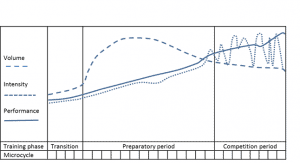Annual plan
The main aim of the annual plan in training planning process is to set up the general training phases for the year to ensure the best performance of the specified competitions. The use of the annual plans takes us back to the ancient Olympic games, where athletes used special training for the upcoming competitions. Although they were far from those plans that are used nowadays they still presented preparatory period and a regeneration/rest period after the games.
The compilation of an annual training plan has the greatest conceptual importance; this plan should concentrate on principal positions such as timing, peaking, and workload distribution. Initially the classic approach to annual trainnig planning used one or two macrocycles in one year depending on in and off-season championships.
Figure1 . General overview of the annual training plan reperesenting one performance peak ie. one macrocycle.
The annual periodization approaches described before are valid for preliminary and early specialized athletic preparation, health fitness and recreational training. The benefits of this approach are the high variety and the emotional and physical attractivness of multilateral training (Issurin 2008). However, according to Issurin (2010) there are also several reasons why one, two, or even three peak annual plans might not be the best solutions:
- The number of the important competitions has increased in recent years, that includes several Grand Prix, World Cups, Golden League where the athlete needs to show high level results. Moreover, lots of those competitions are tightly related to high prize money that influence the finanical status of the athlete, and again forcing them to compete at the high level for long period.
- Change in workload. The number of increased competitions and competitive stress on the other hand needs more time for recovery. Therefore the annual training times have decreased during the last decades. „Hours make champions“ has changed for „Knowledge is the key“.
Besides that there are number of contradictions that might reduce the effectivness of elite athletic preparation.
Therefore also so-called block periodization has recently been introduced, that aims to focus on many high level perfomance peaks during the season.
References:
Bompa T. Periodization. Theory and methodology of training. Human Kinetics, Chicago, IL. 1999.
Issurin, V. (2008) Block periodization versus traditional training theory. – J Sports Med Phys Fit, 48: 65–75.
Issurin, V. (2010) New horizons for the methodology and physiology of training periodization. – Sports Med, 40: 189–206.
